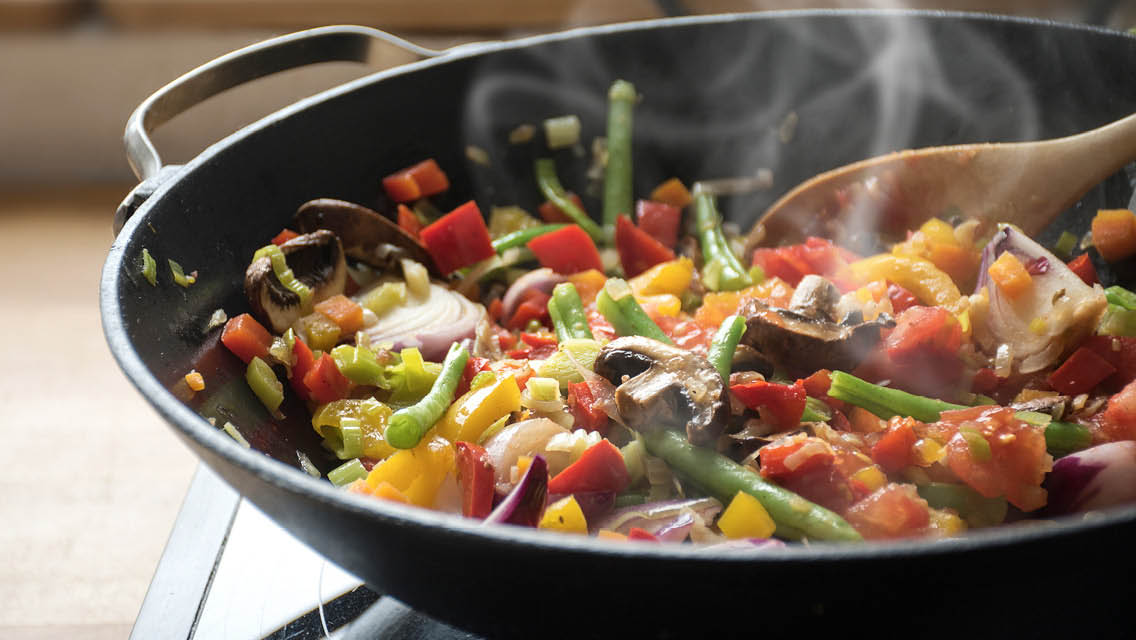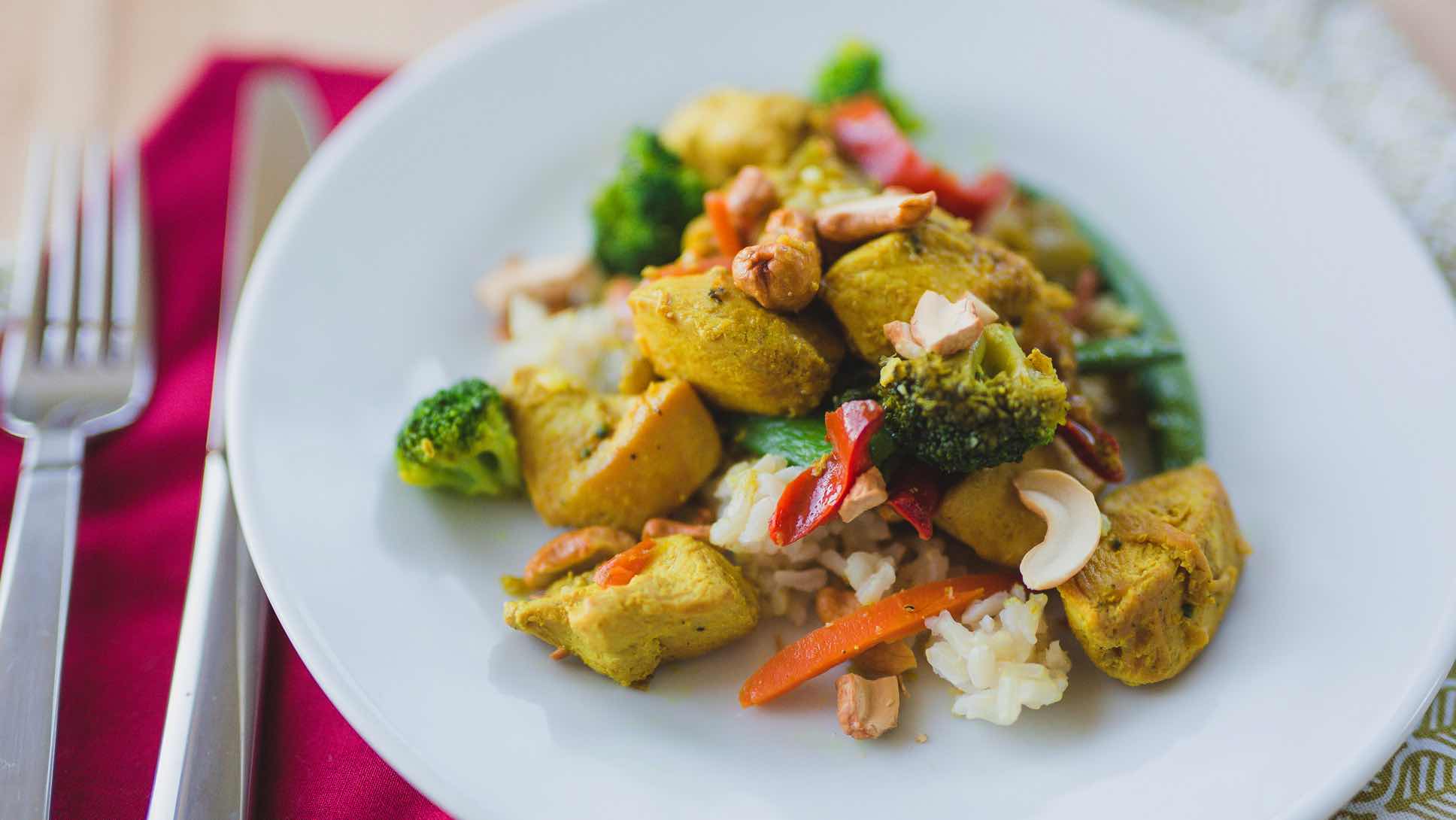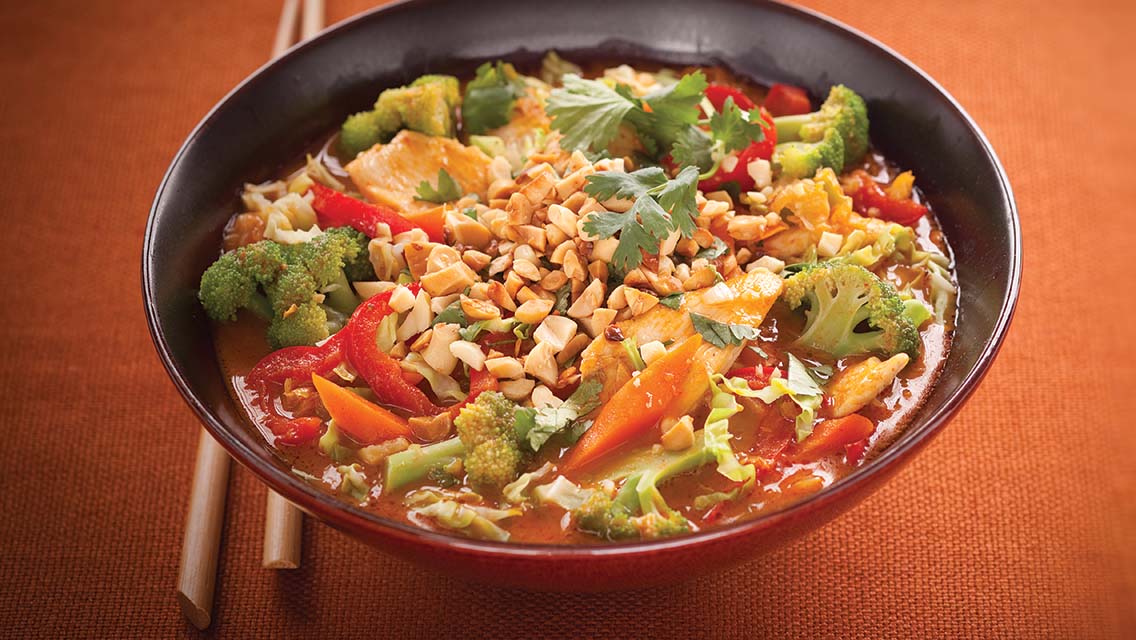One of my culinary maxims is that technique is everything. Even when it comes to something simple – like stir-frying – method truly does matter. I say this knowing that many of you have been using woks for years and probably think you have the art of stir-fry down pat. After all, you can just toss a bunch of stuff into a wok any-old-which-way and call the results a stir-fry, but that’s not really doing the dish justice. And it won’t get you that mouth-watering flavor and aroma that’s always wafting out of really great Asian restaurants.
Look, maybe that dash of soy sauce and assortment of randomly chopped-up vegetables suits you fine. But if you want to experience the fresh, healthy, big-flavor taste that is stir-fry’s claim to fame, winging it probably isn’t your best option. Just as you wouldn’t expect to sink a 30-foot putt the first time you play golf, learning how to stir-fry takes know-how – and practice.
Pan Handling
The first thing that a stir-fryer-in-training needs to do is buy the correct wok. I use mine more than any other pot or pan in my kitchen, so I can say without reservation that investing in a good one is worth it.
A wok can steam, poach, fry, sauté and braise. It heats up quickly and cleans easily because nothing sticks to it. Because of its gently sloping sides, a 14-inch wok has 28 square inches of cooking surface, which is almost double the available acreage of a conventional pan with a similar diameter.
A wok’s unique shape makes it fuel efficient. Heat is concentrated in its deep sides and moves quickly into the bottom, which makes it possible to cook foods fast and evenly and therefore retain flavor. (Note: Electric woks have a nifty temperature control gizmo that makes them great for steaming and frying but lousy for stir-frying; they just don’t get hot enough.)
When used for stir-frying, the wok’s high sides allow you to work vigorously without food spilling over the edges. When used for frying, the wok’s intense heat means that you do not need to use as much oil – a healthy bonus.
There are two types of woks: Cantonese and Beijing. The Cantonese wok has small handles attached to either side of the rim. The Beijing wok, or pau, has a long handle coming out of one side, which keeps the cook at a safe distance from splashing oils and steaming liquids. I like to stir-fry and sauté in my Cantonese wok and steam and deep-fry in my pau.
When choosing a wok, you also need to decide if you want one with a flat or rounded bottom. If you are cooking on an electric stove, I suggest using a flat bottom as it will allow the wok to maintain close contact with your heat source. What’s more, you won’t need to work on top of a “wok-ring,” which is used to keep a round-bottomed wok stable. If you have a gas stove that throws a lot of heat, use a round-bottomed wok with a wok-ring underneath it.
Then there’s the matter of size: Buy a large wok, roughly 14 inches in diameter, with very deep sides. My favorite wok master says that it’s better to make a small batch of food in a large wok than a big batch in a small one, and I agree with him. I also suggest that you make sure that your wok is made from heavy-gauge stainless or carbon steel; the flimsier aluminum models conduct heat poorly and are no better to cook in than a cheap frying pan. One other tip: Avoid woks with non-stick coatings. They hold oil flavors in the coating’s “pores” and won’t maintain high heat as well as conventional woks.
Stir it Up
No cooked meal is faster to prepare, more fully flavored and (if executed properly), healthier than one that is stir-fried.
Here are a few tips to get you on your way:
- Heat the wok until water drops don’t just dance across the surface but actually vaporize. Oil, when utilized, should smoke immediately when it hits the wok’s surface. This gives food the nuanced, smoky rich flavor that is the hallmark of good wok cookery, the taste that the Chinese call “Breath of the Dragon.” Heating oil to smoking can create carcinogenic compounds, however, particularly when using unsaturated fats, which is why you are better off using a saturated fat like peanut oil for this purpose, and in a limited amount.
- Have all your ingredients prepped and ready before you turn on the burner. Stir-frying is a speedy process, so you won’t have time to peel and chop once you start. Set your food up in small bowls so that you can *grab and dump* as the recipe calls for various ingredients.
- Chop all your ingredients, even the meats and sea foods, into similar-sized pieces to promote even cooking.
- Heat your wok before adding your oil. As noted, peanut oil works best for most stir-frying. You don’t need much: Two teaspoons or so swirled across the bottom and sides will coat a wok perfectly.
- Only use the highest of heats. Quick cooking preserves color, texture, flavor and nutrient content. This is the miracle of stir-frying.
- Don’t walk away from the stove. Keep the food in a wok moving. Stir, toss and let the foods go up the sides and then down to the bottom of the wok.
- Don’t crowd the wok. Too much food reduces the temperature of both the pan and the ingredients, which makes foods soggy rather than crunchy.
- Remember that stir-frying is an almost dry process. Proper searing and browning are done with hardly any moisture. The first step in most stir-frying recipes is the oil application. Next up is the addition of aromatics such as ginger, chilies, orange peel, etc. Vegetables and proteins come third. The addition of liquid seasoning (soy, oyster sauce, stock) doesn’t occur until right before you put the food on the plate. If you want a thicker sauce, the addition of a cornstarch-and-water slurry can be tossed in at the end, but is totally optional.
Ready, Set, WOK!
The first thing you will need to do after you buy your wok is to season it:
- Scrub it with hot water and a gentle cleanser to remove the thin layer of machine oil that is usually applied when the wok leaves the factory.
- Dry the wok, place it on low heat and rub 3 tablespoons of vegetable oil over it with a paper towel. Keep the wok on the low heat for 10 minutes.
- Now wipe it again with a paper towel – it should pick up a lot of black soot.
- Discard the towel and repeat the process of coating, heating and wiping three or four times. You’ll know you are done when the paper towel doesn’t blacken.
- Once your wok is seasoned, proper cooking techniques will keep it clean and “stick-free.”
- A few other basic maintenance procedures: Get the wok very hot before applying oil for stir-frying. Only use hot water to clean it. Dry the wok well. If it rusts, clean and reseason.
Shrimp and Asparagus with Chili-Garlic Sauce
- 1 pound large shrimp, peeled and de-veined
- 1 pound asparagus, trimmed, ends discarded and spears sliced on a 45-degree angle
- 1 tbs. peanut oil
- 2 tsp. minced ginger
- 1 tsp. minced garlic
- 1 tsp. sugar
- 1 dry whole hot chili
- 1 cup minced scallions
- 1 tbs. (or more if you like the taste) fermented bean sauce seasoned with chilies (Toban Djan, available at Asian Markets or at unitednoodles.com)
- 2 tbs. oyster sauce
- 2 tbs. hoisin sauce
- 2 tbs. Chinese rice wine, shao xing, or try Japanese sake!
- 1 tbs. cornstarch, mixed with 1 tbs. water (optional, for thickening sauce)
Directions
- Place a large wok over high heat for 5 minutes. Add the oil and swirl. Add the ginger, garlic, chili, sugar and scallions.
- Swirl and toss and add the shrimp, letting sit for 45 seconds before tossing and adding the asparagus.
- Stir and toss contents of the wok for 2 minutes and add the bean sauce, oyster sauce, hoisin and rice wine.
- Cool for a minute and add the corn starch slurry. Toss briefly and plate. Season with sea salt to taste and serve with jasmine rice.
This article has been updated. It was originally appeared as “Stirring Stir-Fries” in the May 1, 2003 issue.





This Post Has 0 Comments